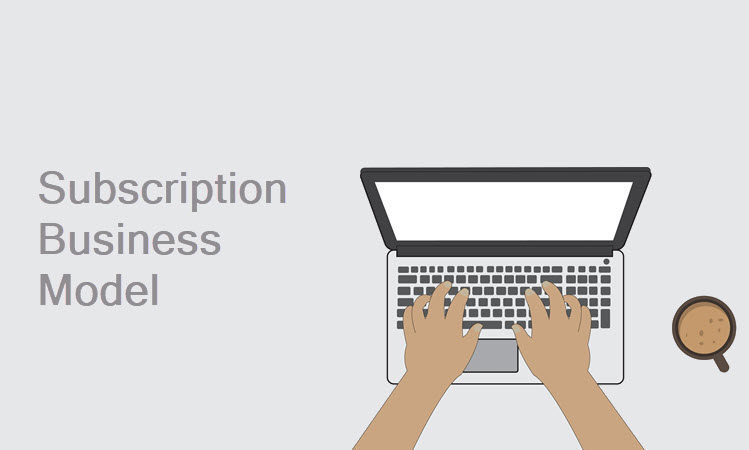Subscription-based businesses have been around for a while but in recent years they have experienced rapid growth. From software to beauty products and gym memberships, subscriptions have expanded their offerings to satisfy the changing needs and payment preferences of customers today.
For merchants, the subscription business model offers several advantages, including a recurring revenue stream, decreased marketing expenditure, and a strengthened bond with customers.
In this article, learn about the basics of a subscription business model and the benefits it brings to ecommerce businesses.
What Is a Subscription Business Model?
A subscription business model is based on charging recurring payments for goods and services. Rather than constantly acquiring new customers, the main goal is to retain existing ones by encouraging them to renew their subscriptions.
The model rests on building a long-term relationship between a business and its customers, to the benefit of both parties. The company ensures a steady revenue flow while customers benefit from making smaller payments rather than one large up-front payment. Additionally, customers like being able to cancel their subscription at any time, which adds to the overall flexibility and value of the experience.
Almost all industries can implement this business model, at least in some form, and Gartner predicts that by 2023, 75% of direct-to-consumer ecommerce businesses will offer subscription services.
How Does a Subscription Business Model Function?
In a subscription-based business model, customers agree to pay a recurring fee for access to products and services. Subscriptions are usually renewed automatically, on a monthly or annual basis.
The business collects the subscription fee by charging the customer’s pre-authorized credit or debit card. eChecks and ACH payments are other convenient and inexpensive ways of receiving subscription payments.
The customers choose how long they want to use the services. They are usually reminded that the subscription renewal is coming up in case they want to cancel it or switch to a better subscription plan.
Subscription Businesses — Market Overview
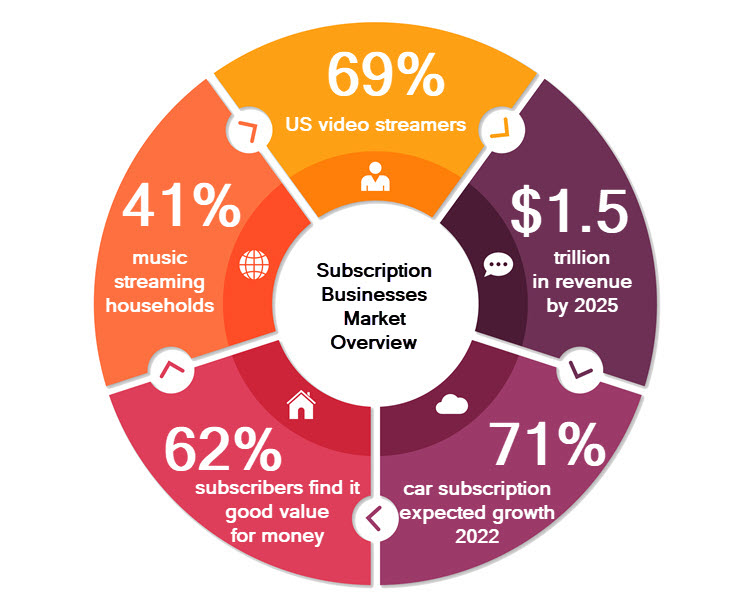
Here are the most important statistics regarding the subscription business model:
- According to Deloitte, 69% of US consumers are subscribed to one or more video streaming service.
- The same study shows that 41% of households are subscribed to one or more music streaming service.
- The subscription economy is expected to reach $1.5 trillion in revenue by 2025, while streaming services will reach $155 billion.
- 62% of subscribers believe that their subscription is good value for money.
- The car subscription industry is expected to grow 71% by the end of 2022.
Benefits of a Subscription Business Model
The subscription model owes its success to the range of benefits if offers to both customers and merchants. Here are some of the most important advantages:
1. Encourages Strong Customer Relationships
This model rests on an ecommerce business’s ability to maintain and grow its customer base by building loyalty and strengthening relationships. To do this, they have to consistently provide high-quality goods, services, and customer support. These factors all come into play when a billing cycle is up, and customers decide whether to renew or cancel their subscriptions.
Note: Learn how to avoid cancelled subscriptions by reading our article 12 Subscription Cancellation Reasons and How to Avoid Them.
2. More Accurate Revenue Predictions
Businesses can more accurately forecast recurring revenue. Having a precise picture of future funds helps a business manage their inventory and plan expenses. A steady and predictable revenue stream is also an attractive proposition to investors.
3. Lower Marketing Costs
This business model has a naturally lower churn rate, helping to decrease the amount a company spends on marketing its product to new and one-time customers. The unique value of the subscription does the heavy lifting of convincing customers to stay with the business, decreasing customer acquisition and retention expenses. The data gleaned from the constant customer engagement that comes with this business model allows companies to create highly focused and effective email campaigns.
4. Attractive Pricing Scheme
Ecommerce subscription businesses can build a more affordable pricing strategy to offer to their customers. Instead of focusing on a single, large payment upfront, these businesses can create different pricing schemes to suit different customer needs. Another benefit to offer customers is a special discount when they decide to get an annual, rather than a monthly subscription.
Customers appreciate the lower costs and perceive a subscription as a less burdensome financial commitment. This is because the payments are smaller, they are spread over time, and can be cancelled at any point.
Note: Learn about providing subscription customers with a free trial for a limited period using negative option billing.
5. More Value for the Business (and Customers) Over Time
The subscription business model focuses on building a lasting relationship with the customers and increasing their satisfaction with your services. They have the flexibility to choose which features they will use and pay for, while you can offer them to switch to a better subscription plan based on their previous interests and searches. This translates to an increase in the customer lifetime value (LTV) and a higher renewal rate.
6. Better Customer Insights
Subscription businesses get better insights into customers’ satisfaction with their products and services by learning directly which features they like the most and which parts of their business lead to unsubscribing. This significantly decreases the costs and efforts for market research and promotion, since you have a direct insight into your customers’ interests based on the subscription plans they choose for themselves.
How to Build a Subscription Business Model

These are the steps to take when building a subscription business model:
1. Decide If the Business Model Is Beneficial for Your Business
Not all products and services are suitable for the subscription business model. It needs to be something customers need on a daily, weekly, monthly, or annual basis. Businesses that benefit most from this model include media content providers, eBook distributors, gyms, and SaaS providers, to name a few.
2. Find Your Customer
Ask yourself what kind of client base you want to attract and find your ideal customer. Depending on the answer, you will be able to build a pricing model for your subscription business.
3. Determine a Pricing Strategy
Creating a pricing scheme involves establishing the prices, packages, and subscription levels you will offer to customers based on their needs and loyalty.
Note: Subscription businesses have more than one pricing option. Learn about different pricing models from our article 4 Subscription Pricing Models for Recurring Revenue.
4. Reach Your Customers Easily
Connect with your customers where they spend their time – give them an omnichannel customer experience. It will allow a seamless transition between different communication channels and increased content consumption through images, videos, emails, social media posts, etc.
5. Simplify the Process
To convert visitors to subscribers, make signing up as simple as possible. This includes having a clear and visible sign up/login button on every page which will lead to a separate page with clear instructions on how to subscribe. This way, they will sign up without losing progress on the website.
6. Track Subscription Business Model Metrics
The following subscription business model metrics indicate how successful a business is:
- Monthly recurring revenue (MRR). Monthly recurring revenue is the amount of money a company makes from its monthly subscriptions. When forecasting monthly recurring revenue, consider the variables, such as the number of new and lost customers.
- Annual recurring revenue (ARR). Annual recurring revenue is the total revenue that a subscription business has made within one calendar year.
- Customer acquisition cost (CAC). The customer acquisition cost is the amount of money that a company spends to familiarize users with its products and turn them into customers.
- Customer lifetime value (CLV). Customer lifetime value is the expected amount of money a subscriber will spend on your products and services.
- Subscribers return on investment (ROI). To find out how much money you return per subscriber, divide the customer lifetime value by the customer acquisition cost. The perfect ratio is between 2:1 and 4:1.
- Average revenue per user (ARPU). To get this metric, divide the total revenue within a specific period by the number of subscribers. Businesses that use tiers can calculate ARPU within a single tier or for all tiers together.
- Growth efficiency. Growth efficiency indicates recurring revenue growth per 1$ invested in marketing.
- Churn rate. The churn rate is the percentage of users that stop paying for a subscription within a specific period.
- Lead velocity rate (LVR). Lead velocity rate shows how successful a company is in generating new leads. The metric represents the difference between the number of qualified leads during two compared periods.
Note: For an in-depth look at how to build a subscription business, read our step-by-step article How to Start a Subscription Business.
Best Subscription Business Models: 10 Examples
Here are some notable examples of subscription business models:
1. SaaS (Software as a Service) Companies

A SaaS business gives users access to software that automates and optimizes processes, offers digital storage and other services. The advantage for users of obtaining software this way is that they do not need to worry about site maintenance, since they are using someone else’s service hosted on their website and not their own, and all updates are incorporated into their software version. Meaning, they do not need to redownload to keep using the services.
2. Subscription Boxes

Subscription boxes contain curated products the customers want to like to receive on a monthly or annual basis. Alternatively, they can also receive boxes with mystery items or surprise gifts from the company, making them feel valued. These products include anything from hobby supplies to luxury goods, make up, etc. Usually, the products in the subscription box cost less than they would if bought separately.
Example: Birchbox, Glossy Box.
3. Digital Publications and Newsletters
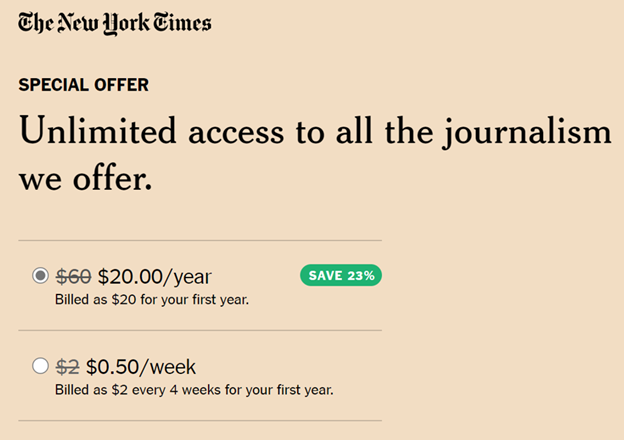
Physical newspapers have experienced steep circulation decline with the rise of internet news so now the biggest publications in the world such as The New York Times and The Financial Times also provide their content digitally. Newspapers and magazines frequently restrict the content readers can retrieve by using a paywall. By subscribing, users get the benefit of unrestricted access to articles and an ad-free experience.
Example: The New York Times, The Guardian newsletter.
4. Video and Music Streaming Platforms
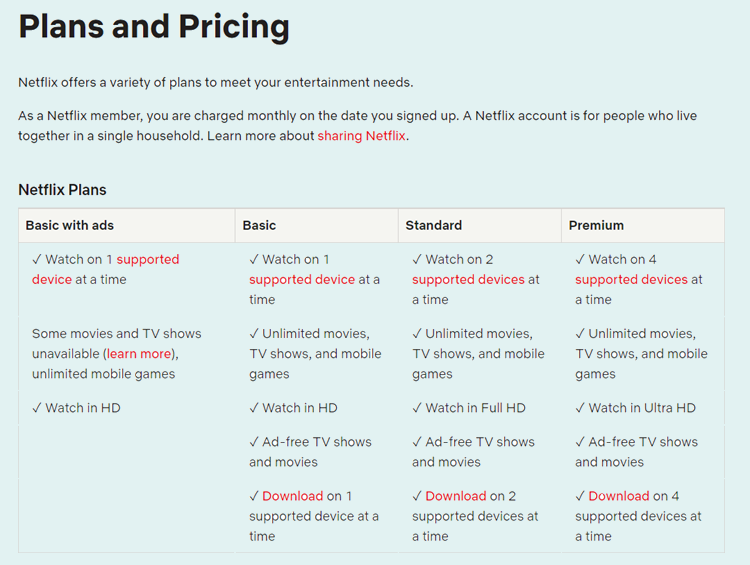
Video streaming companies are moving viewers away from film studios by producing their own content to distribute for a subscription fee. Users also have access to a library of genres so now they can watch their favorite movies and TV shows anytime and on any device.
When it comes to music, artists are now signing deals directly with streaming companies instead of releasing their music elsewhere and waiting to gain traction.
5. Maintenance and Repair Companies

More and more consumers are willing to pay a monthly fee to a single company for services such as maintenance, pest control, heating and cooling, and home repairs instead of having to search online for a repairman every time something malfunctions. This provides customers with peace of mind and companies with a steady cash flow each month.
Example: Homekeep, Hello Super.
6. Meal Kit Subscription Companies
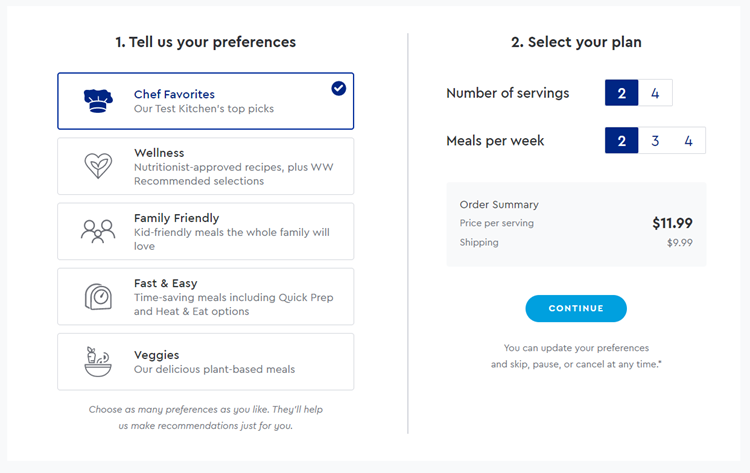
Food companies offer customers daily deliveries of either ready-made meals or meal-kits, which include recipes and pre-measured ingredients. Based on their dietary preferences, customers can also choose the size, type, and number of meals they receive. This saves time otherwise spent shopping for groceries and preparing meals, which is why many consumers love this option.
Example: Blue Apron, Hello Fresh.
7. Gym and Wellness Subscription Model

Users subscribe to workout plans and online classes where they can interact with trainers or receive a tailored workout and meal plan for a monthly fee. Other advantages customers obtain include special courses, access to past and missed classes, support, and workout equipment.
Example: Fitness Blender, Gaia.
8. Car Subscription Companies
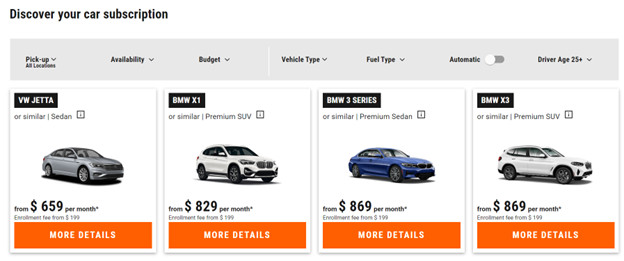
Car subscriptions refer to renting a vehicle on a monthly basis. Aside from using the vehicle, subscribers also typically get additional services such as road assistance, maintenance, registration, etc. This arrangement is much more affordable than a lease, which includes a long-term commitment.
Example: Sixt+, Enterprise.
9. Coffee Subscription Companies

For a monthly fee, coffee chains offer customers daily deliveries or in-store pick-ups of their favorite caffeinated drinks. Coffee-lovers can also subscribe to receive special coffee blends for home use.
Example: Pret, Blue Bottle.
10. Clothing Renting Companies

Clothing rental companies allow their customers to rent out several outfits per month. Customers love to be able to wear high-end and luxury clothing items for special occasions.
Example: Rent the Runway, Nuuly.
Conclusion
A subscription business model is a great opportunity for businesses to increase their profit and strengthen customer relationships while significantly lowering the costs of customer acquisition. Customers love convenience of receiving goods and services regularly and without much effort, and the lower costs of subscriptions as opposed to one-off purchases.
Take advantage of the opportunities this business model offers to improve your business’s bottom line and build financial resilience through predictable revenue flows.
